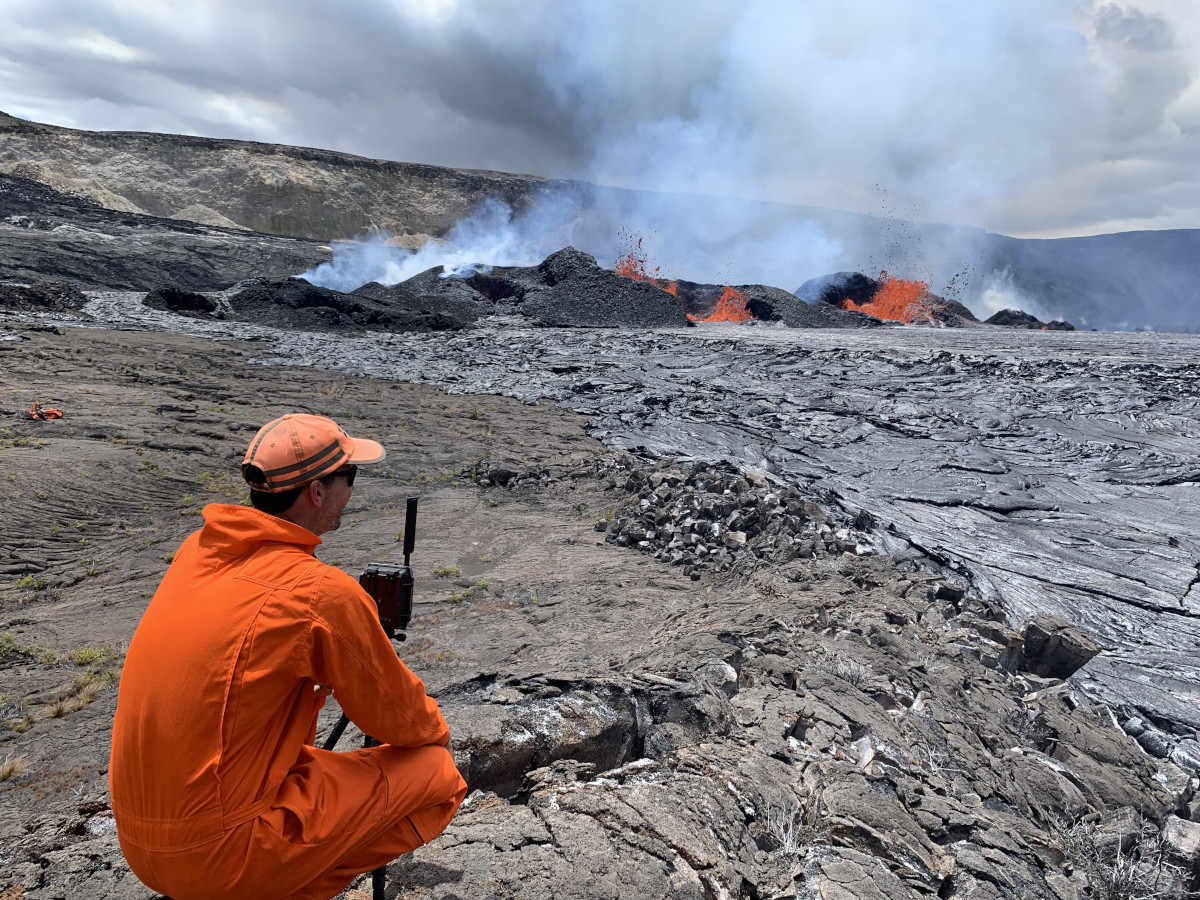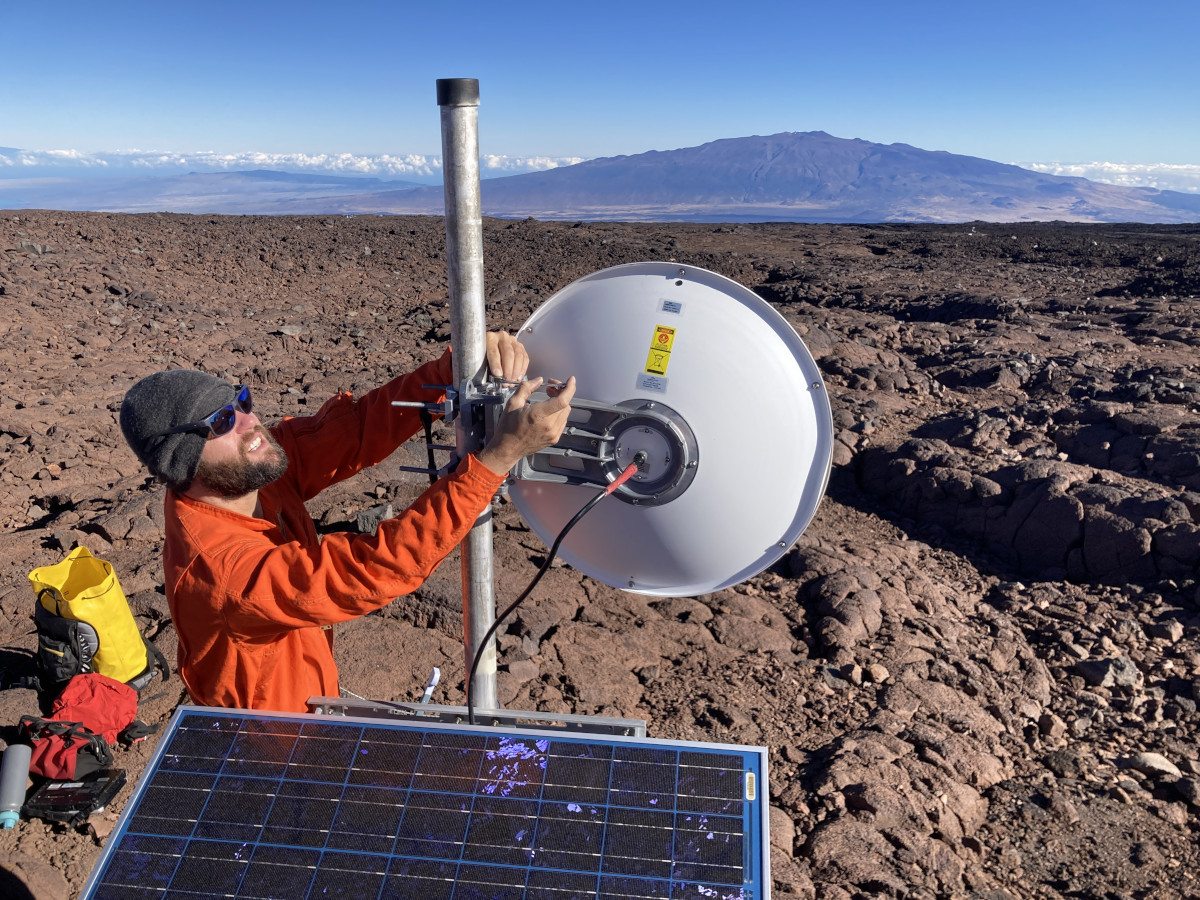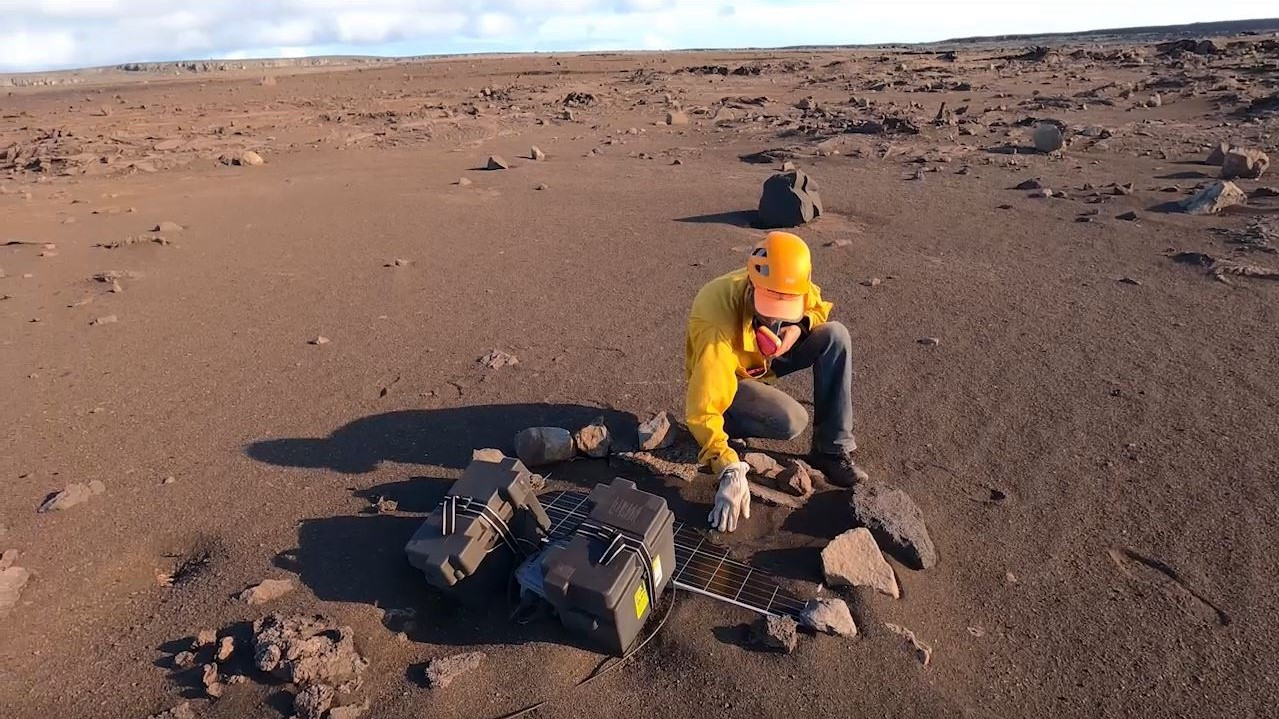
USGS: “A Hawaiian Volcano Observatory geologist sets up remote cameras for a close-up view of the September 2023 eruption within Kīlauea summit caldera. These cameras will help capture changes in the eruption’s behavior so that geologists studying the volcano can determine better the processes at work that create the lava fountains.” (USGS photo by D. Downs)
(BIVN) – From this week’s Volcano Watch article, written by U.S. Geological Survey Hawaiian Volcano Observatory scientists and affiliates:
Active volcanoes are inherently hazardous places to work. Even when a volcano is quiet, volcanic gases, ground cracks, earthquakes, and uneven surfaces can be unsafe. Advanced planning and preparation for fieldwork in these environments is critical to reducing the personal risk of volcanic hazards to field crews.
At the USGS Hawaiian Volcano Observatory (HVO), field work is critical for monitoring and understanding our volcanoes. All the time spent in the field exposes staff to many potential hazards, whether or not they are working in areas near active eruptions. Staying safe while performing mission-critical work is our main priority.
Most of HVO’s field sites are more than one hour from definitive medical care, so staff take Wilderness First Aid training which prepares them for a variety of injuries and illnesses. Heat-related illnesses, hypothermia, and altitude sickness are major concerns with the wide range of environments on Hawaiian volcanoes from sea level to over 13,000 ft (3,960 meters) elevation.

USGS: “On November 8, 2023, Hawaiian Volcano Observatory (HVO) staff visited the rim of Moku‘āweoweo (Mauna Loa’s summit caldera) to service the MLcam and the MTcam. In this photo, an HVO technician adjusts the antenna that transmits the webcam data back to the observatory.” (USGS photo by M. Patrick)
When working in hazardous conditions fieldwork typically includes at least two people for situational awareness, to decrease the amount of time needed to complete a task in potentially dangerous conditions and helping a field partner in case of injury or illness. Each crewmember carries at least two modes of communication just in case there is no service or the device batteries are depleted. Commonly used communication devices include cell phones, radios, satellite messaging devices, and satellite phones.
Before fieldwork starts, the crew will discuss the work that needs to be done, identify any potential hazards that may be encountered, and what can be done to mitigate those hazards. For example, if a crew is dropped off at a remote site by helicopter, they will bring extra food and water along with overnight gear in case weather conditions prevent the helicopter from extracting them.
Each field crew designates a point of contact (POC). The crew will check in with the POC before they begin fieldwork, and again when they end for the day. The POC will communicate any relevant information to field parties, including significant changes in monitoring data and weather that might warrant an immediate cancellation of fieldwork. In extreme cases, the POC will initiate search and rescue procedures if the crew fails to check out or cannot be reached.
We avoid working in high-hazard locations whenever possible, but sometimes field crews need to access these areas for mission-critical work. When this is the case, additional safety precautions are taken. Hazardous areas, such as the closed areas of Hawaiʻi Volcanoes National Park (HVNP) are only accessed by essential crews who carry personal protective equipment (PPE) with them. Common PPE used in the field by HVO staff include respirators to filter volcanic gases, gas badges to monitor sulfur dioxide (SO2) concentrations, along with helmets and eye protection. When molten lava sampling, crews will carry a face shield, fire-resistant clothing, and gloves to protect the wearer from radiating heat. HVO access to the closed area is by permission from, and in coordination with, HVNP.
Numerous other hazards can be encountered on volcanoes in Hawaii. Earthquakes can occur without warning and increase the hazard of rockfalls, ground cracking, and cliff instability, especially around the rim of Halema‘uma‘u crater at the summit of Kīlauea.
Even seemingly benign environments have associated hazards. For example, the surfaces of lava flows, even ones that are decades old, are uneven and sharp. They can be difficult to walk on, with tripping hazards and possibility of lacerations if you fall. There are many sub-surface void spaces below seemingly solid ground, which can cause injuries such as ankle sprains or cuts if you break through. Volcanic gas levels can also remain hazardous near vents even after an eruption has ceased. When visiting HVNP it’s important to stay on marked trails and not enter any closed areas.
Visiting Hawaii’s volcanoes is an awe-inspiring experience, but it can also be a hazardous one if you aren’t careful. HVO staff are aware and prepared; you, too, should stay informed and be familiar with volcanic hazards and HVNP safety tips before hitting the trails.


by Big Island Video News7:24 am
on at
STORY SUMMARY
ISLAND OF HAWAIʻI - In this week's Volcano Watch article, scientists explain how they work safely in hazardous environments.